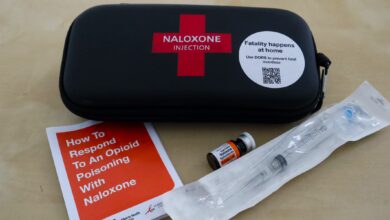Practicum student falls through the cracks after injury
Practicum students are meant to be covered by the WCB and the U of A's insurance and risk management. That wasn't the case for Lee Pearson.
 Helen Zhang
Helen ZhangWhen Lee Pearson went back to school to get his teaching degree, he thought he would get to pursue a career that he loved. Instead, he got a brain injury and is struggling to access the proper supports.
Lee had gotten a criminology degree from the University of Alberta in 2018 and spent some time in the military. But he found that he loved being an educational assistant (EA).
“I actually really enjoyed it, but they don’t pay very well … so I was like, I’ll come back as a teacher,” Lee said.
He began his education after degree at the U of A in 2022. It was during his second practicum with the Grande Prairie and District Catholic Schools that he got injured.
“I was teaching a class in the gym. Half of my students were away on a ski trip, along with my usual mentor teacher,” Lee said. “I just had I think like eight students that day. So most of them were just playing basketball and I was just throwing a football with one of my other students.”
A student tried to intercept the football and ended up knocking into Lee.
“I jumped for it, and instead of him going around, he went through. So he hit me in the back and then my head hit the ground,” he explained. “I couldn’t get up.”
“There is nobody at the U of A, no student union, nobody will come forward and help,” Lee’s mother says
Lee had a concussion and bruising between his C2 and C6 vertebrae. He’s still dealing with the pain, but surgery is a last resort because of how young he is.
Lee also struggles with his memory and emotional regulation as a result of the injury.
After the injury, Lee had trouble claiming under the Workers’ Compensation Board (WCB). His first application was rejected, but his second was accepted. WCB is covering his medications and his treatment.
However, because he wasn’t getting paid a wage, Lee didn’t qualify for employment insurance (EI) or the Canadian Pension Plan (CPP). His mother, Jackie Pearson, helped him get some income through other supports but said it is set up for short-term unemployment, not long-term cases like Lee’s.
In other school districts, like Edmonton Public Schools, practicum teachers are insured by the schools. That wasn’t the case in Grande Prairie, according to Lee.
Edmonton Public Schools confirmed to The Gateway that they provide coverage for practicum students while they are doing a placement in the division.
Lee said the U of A didn’t insure him either. He said there was confusion over who was responsible for him — the U of A or the school in Grande Prairie.
Now, Lee is stuck in a grey area. He is no longer a student, having graduated with his teaching degree, but can’t prove he would have had income after graduation.
“We have phoned everybody and anybody we could think of. There is nobody at the U of A, no student union, nobody will come forward and help,” Jackie said. “We haven’t received any phone calls from the dean’s office or anybody else here to see how Lee is doing.”
WCB coverage for learners and apprenticeships
The Workers’ Compensation Act (WCA) regulates the WCB and its administration of workplace injury insurance.
Section 67 of the WCA covers the compensation of a learner or apprentice. Section 67 (1) states that if a worker who is a learner faces impairment of earning due to an accident, their compensation “must be calculated on the same basis as if the worker were, at the time of the accident, a beginner in the industry in which the worker was a learner.”
Additionally, Section 67 (2) outlines that an apprentice in an approved industry is entitled to periodic compensation if they suffer an accident impacting their ability to earn wages.
“The Board may grant the worker an adjustment in the periodic compensation at the time that the worker would, in the normal course, have completed the worker’s apprenticeship education program or, if applicable, received certification in the worker’s trade,” Section 67 (2) reads.
For Jackie and Lee, they’re concerned that the wording is too specific to apprenticeships in trades and doesn’t adequately address practicum placements in areas like education, nursing, or others more often taken at the university level.
The Gateway requested comment from Myles McDougall, the Alberta minister for advanced education, but did not receive any before deadline.
Students should be covered like any other worker, according to WCB
The Gateway spoke with Ben Dille, who works in the communication department of the WCB. He said that any student registered in a post-secondary institution is essentially covered as a worker like any other would be.
Dille explained that because post-secondary institutions fall under the Post-Secondary Learning Act (PSLA), students are covered by the Government of Alberta.
He said that a typical workplace injury requires three reports: one from the employee, the employer, and the health-care provider.
Lee said in his case, there was confusion between the school he was doing his practicum with and the university over who his employer was. Because of that, it delayed his WCB claim.
Dille said that his colleagues in client services don’t often encounter confusion over who the employer is.
In terms of what coverage students may receive, it may differ from someone who is a full-time employee, according to Dille. He said it varies from case to case, but likely students would have coverage for medical treatment.
In some cases, students can also receive compensation for having to miss work at their concurrent job due to an injury during their practicum.
Sometimes there’s also support available through WCB if someone has to pursue a different career path due to their injury.
“That’s something that we would look at, probably something that’s unlikely for most students, but it’s a possibility depending on the nature of the injury,” Dille said.
Compensation for young workers who are injured
Dille also mentioned that there’s a provision in the WCA regarding young workers.
Section 68 of the WCA covers the increased compensation for young workers. The section applies to workers who are under the age of 25 or are over 25 but enrolled in a vocational or academic program approved by the WCB.
The section also requires that the worker’s net earnings do not exceed Alberta’s average weekly earnings as outlined in a yearly Statistics Canada report.
Additionally, the worker must have been assessed to have a permanent 50 per cent or higher clinical impairment or have “been receiving compensation for temporary disability for 24 months after the date of the accident and is expected to have a permanent clinical impairment of 50 [per cent] or higher.”
In Lee’s case, he would fulfill most of the requirements, but was not earning any wages at the time of his accident.
Dille also explained that if someone has insurance through another provider, the insurance typically waits for WCB to make a decision. If the claim is accepted “private insurance steps back.” If the claim is denied, private insurance could come in and provide coverage.
U of A meant to cover students doing practicums
No one from the university was made available for an interview before publication. The Gateway contacted the Risk Management and Insurance Office, and was directed to public links about WCB coverage.
According to the university’s “General Liability” page, the U of A covers directors, employees, officers, and volunteers acting on behalf of the U of A. Students are covered “while performing any duty or taking part in any activity which is considered as part of regular or supplemental studies connected with the U of A.”
The page says that all costs that the “U of A is legally obligated or responsible to pay as damages/losses for bodily injury, personal injury or property damage to others (third parties) arising out of the ownership, use of all premises and/or operations, and activities of the U of A” are covered.
The Gateway was also directed to the U of A’s “Student WCB Coverage and Reporting” page. There it states that students “may be covered by WCB for injuries that arise from participating in an activity that is in the direct pursuit of their degree or accreditation.”
According to the site, a student must be an Alberta resident and registered in and physically attending a U of A program that leads to recognized degree or certification.
Practicum students are covered by the WCB if they are doing a placement with an Alberta employer as long as they are either registered and attending or are a Canadian citizen doing distance learning.
“The service offered through the [SSE] ensures that students are provided with any required care and support,” university says
U of A media relations told The Gateway in an email that the university could not comment on “any specific case” due to “privacy legislation.”
The university did explain that the U of A “works in partnership with employers to ensure that students are covered by WCB during their placements. The university helps facilitate the necessary documentation for students to be enrolled in the WCB system for the duration of their placements.”
It also said that practicum students are automatically insured for placements that are apart of their academic program.
“The service offered through the Student Success and Experience [(SSE)] portfolio ensures that students are provided with any required care and support,” the email said. “Through contact with one of our Student Care Co-ordinators, a student is provided with any resources on campus that may be of assistance.”
But Jackie and Lee say they didn’t receive support from the U of A.
Feeling like they were out of options, Jackie and Lee contacted Heather Sweet’s office. Sweet is the Member of the Legislature of Alberta (MLA) for Edmonton-Manning. She is also the shadow minister for agriculture and irrigation.
Sweet and her office has helped them navigate a lot of the problems Lee is facing, Jackie said.
Her office provided The Gateway with a statement over email about protections for practicum students.
“This is a tragic incident and all families should expect their loved ones are able to come home safe,” the statement read. “Regardless of who you are, all of Alberta’s workers should have some sort of worker compensation and protection.”
UASU crafting a new Experiential Learning Policy
Katie Tamsett, the vice-president (academic) at the U of A Students’ Union (UASU), answered some questions over email.
In regards to concerns from students around placements, Tamsett said “the UASU provides direct support when students raise concerns.
“It can advise students and connect them with other supports such as the university Ombuds Office, Student Legal Services, faculty practicum coordinators, and university offices handling harassment or violence cases. The emphasis is on guiding students toward the proper pathways if issues arise during a placement.”
Tamsett said the UASU’s advocacy around practicum placements currently focuses on unpaid placements. As part of this, the UASU is drafting a Experiential Learning Policy, which will eventually replace the Practicum Intervention Policy.
“With the new Experiential Learning Policy, students will continue to be protected. It will be important for the UASU to continue working with the university to ensure that effective communication is provided to students.”
Whether the policy will address some of the issues Lee faced is yet to be seen. Jackie and Lee are hoping something will change so others don’t end up in the same situation. Whether that change happens at the university level, within the WCB, or at the legislative level.
But according to Jackie, the likelihood of Lee being able to go back to teaching is extremely low. Lee currently can’t work for more than two hours at a time.
“His psychologist and his neurologist are just pleased that we can at least do an hour of [volunteering] a week,” Jackie said. “So it’s going to be a really incredibly slow process.”




